



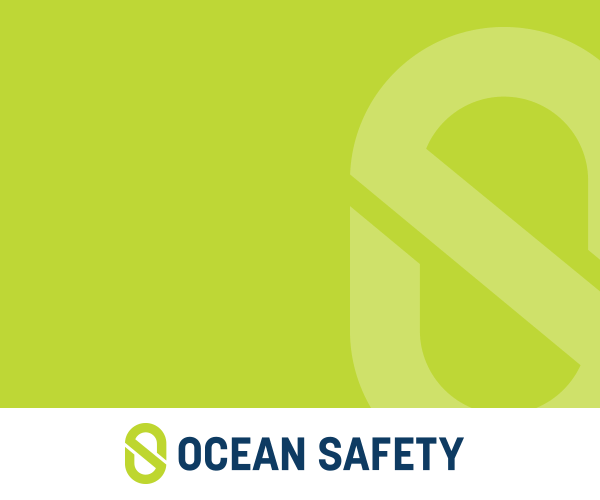
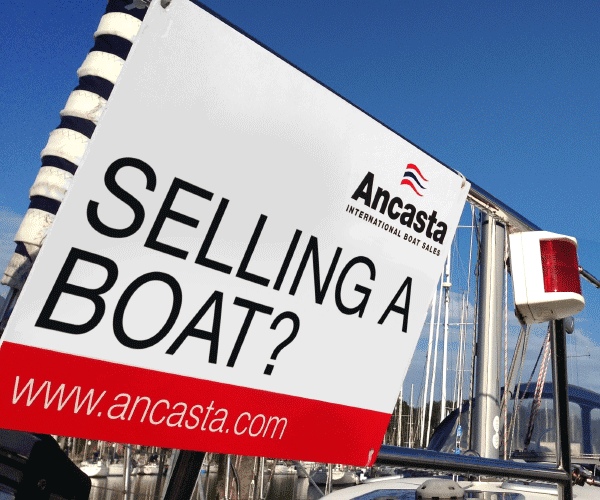



-(1)-202408140552.gif)



Boats for sale
| Rossiter Pintail Mortagne sur Gironde, near Bordeaux |
 |
| Free mast for Merlin Rocket - has a bend! Guildford |
 |
| Bruce Roberts classic 45 Valencia, Spain |
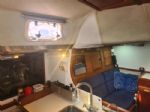 |
List classes of boat for sale |
Weight equalisation |
Post Reply 
|
Page <1 7891011 13> |
| Author | ||||||
tink 
Really should get out more 
Joined: 23 Jan 16 Location: North Hants Online Status: Offline Posts: 789 |
 Post Options Post Options
 Quote Quote  Reply Reply
 Topic: Weight equalisation Topic: Weight equalisationPosted: 03 Jan 22 at 5:33pm |
|||||
|
page 181 of Frank Bethwaites "High Performance Sailing"
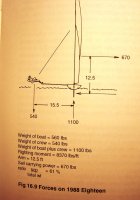 |
||||||
|
Tink
https://tinkboats.com http://proasail.blogspot.com |
||||||
 |
||||||
KazRob 
Far too distracted from work 
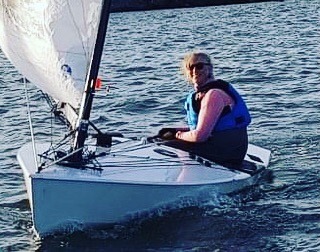
Joined: 22 Oct 16 Location: Scotland Online Status: Offline Posts: 245 |
 Post Options Post Options
 Quote Quote  Reply Reply
 Posted: 03 Jan 22 at 6:12pm Posted: 03 Jan 22 at 6:12pm |
|||||
|
Any basic mechanics book will explain it all. If there is a fundamental problem with these principles I'm sure they would have been noticed by now. As Tink said - all that matters is the overall moment and balance of forces. If you do a free body diagram and include the angles of the wires etc you'll see it makes sense.  |
||||||
|
OK 2249
D-1 138 |
||||||
 |
||||||
Sam.Spoons 
Really should get out more 
Joined: 07 Mar 12 Location: Manchester UK Online Status: Offline Posts: 3401 |
 Post Options Post Options
 Quote Quote  Reply Reply
 Posted: 03 Jan 22 at 6:19pm Posted: 03 Jan 22 at 6:19pm |
|||||
I can't think of a simpler way to explain it...
|
||||||
|
Spice 346 "Flat Broke"
Blaze 671 "supersonic soap dish" |
||||||
 |
||||||
Guests 
Guest Group 
|
 Post Options Post Options
 Quote Quote  Reply Reply
 Posted: 03 Jan 22 at 6:40pm Posted: 03 Jan 22 at 6:40pm |
|||||
|
Sorry, but there hasnít been an explanation as to why the trapeze wire coming out at a more horizontal angle if attached higher up the body doesnít increase the righting moment. The only explanation given is that righting moment = body weight x distance from centre of buoyancy, which is correct but doesnít explain why the trapeze angle method is wrong. After all, if you were trying to pull a tree over you would find it easier if pulling more horizontally and less down (from the same attachment point) so why isnít the same true for dinghy stability?
|
||||||
 |
||||||
Sam.Spoons 
Really should get out more 
Joined: 07 Mar 12 Location: Manchester UK Online Status: Offline Posts: 3401 |
 Post Options Post Options
 Quote Quote  Reply Reply
 Posted: 03 Jan 22 at 6:45pm Posted: 03 Jan 22 at 6:45pm |
|||||
|
Because to pull more horizontally/less down you would have to stand further from the tree (for the same attachment point on the tree). If you stood further from the boat (either on stilts or WHY) you would have a higher downward force not because of the angle of the trap wire but because you were further from the boat. But it's not a valid analogy because to pull the tree down you would be pulling sideways and the sideways component of your effort would be what pulls the tree over not the vertical component.
|
||||||
|
Spice 346 "Flat Broke"
Blaze 671 "supersonic soap dish" |
||||||
 |
||||||
Guests 
Guest Group 
|
 Post Options Post Options
 Quote Quote  Reply Reply
 Posted: 03 Jan 22 at 6:47pm Posted: 03 Jan 22 at 6:47pm |
|||||
|
No, the trapeze line (or tree rope) is more horizontal if the line is attached at the chest rather than the knees. The man is no taller and has no more inherent leverage.
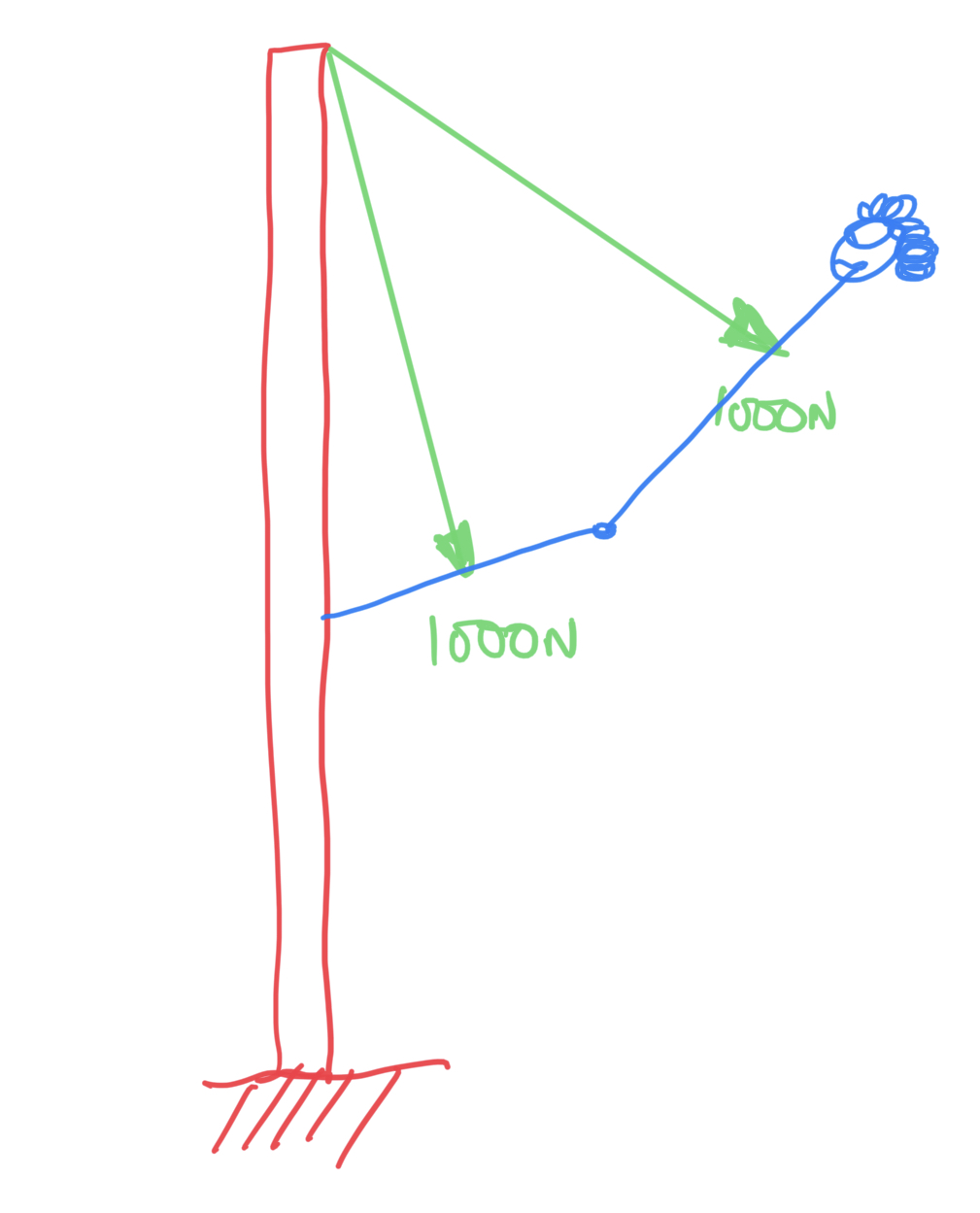 I know the answer to this, but no one has yet explained it despite deriding GRF for asking the question. Edited by A2Z - 03 Jan 22 at 6:54pm |
||||||
 |
||||||
Grumpycat 
Far too distracted from work 
Joined: 29 Sep 20 Online Status: Offline Posts: 497 |
 Post Options Post Options
 Quote Quote  Reply Reply
 Posted: 03 Jan 22 at 6:48pm Posted: 03 Jan 22 at 6:48pm |
|||||
No she is a a saint in human form
 |
||||||
 |
||||||
Sam.Spoons 
Really should get out more 
Joined: 07 Mar 12 Location: Manchester UK Online Status: Offline Posts: 3401 |
 Post Options Post Options
 Quote Quote  Reply Reply
 Posted: 03 Jan 22 at 6:53pm Posted: 03 Jan 22 at 6:53pm |
|||||
Yes
No, the crew's CoG is still only 2.5m from the mast foot
Yes, it's purely the hight of the sailor (or more correctly how far, horizontally, from the mast foot his CoG is
See above
Yes
No, different forces, the CoG of the 90kg crew is roughly at his navel, say 1m from his feet. Now lets assume he can use toe straps just outboard of the gunnel and flat hike with his feet touching the gunnel, his CoG will be 1m out from the gunnel regardless of how wide the racks are (as long as they are wide enough for him to hike off). Now remove the racks and put him on a trap wire so he can stand horizontally off the gunnel with his CoG in exactly the same place relative to the boat and he will generate exactly the same righting moment and will be able to balance exactly the same amount of power from the rig. I'm almost tempted to make a mock up to prove it but have other stuff I have to do first.
Edited by Sam.Spoons - 03 Jan 22 at 6:58pm |
||||||
|
Spice 346 "Flat Broke"
Blaze 671 "supersonic soap dish" |
||||||
 |
||||||
Mozzy 
Far too distracted from work 
Joined: 21 Apr 20 Online Status: Offline Posts: 209 |
 Post Options Post Options
 Quote Quote  Reply Reply
 Posted: 03 Jan 22 at 6:58pm Posted: 03 Jan 22 at 6:58pm |
|||||
 changing the heights of the hook or termination on the mast obviously won't effect the moments. But it does change the forces which is of some importance to both the mast (and it's shape and structure) and the human body. Hook height... the further you place the hook up the body the more weight is on the feet. If you move the hook very low, you fall out backwards (or have to start tucking you feet under the gunwale). Generally I prefer a lower hook as it gives a bit more freedom to move the upper body around. If the hook height is very high it gets in the way, but also means more strain holding you bum up with the glutes. The same could be said for a low hook height and holding you shoulders up with your abbs (but you have shoulder straps and back support for that). Hook height on the mast is usually just set to the hounds as from a structural point of view its the best supported point of the mast and usually is still about full section before the mast tapers. So there is less you have to do to the mast to modify it to carry one or more sailors. What is also noticeable on the 800 with the equalisation it that as the racks go out the wires pull you inwards more. So you generally have more load on your feet. The negative is it's noticeably harder pointing your toes. But on the positive side when the boat comes on top you can have more heel before you start to swing away from the hull. Most 800 set their rigs up the same (or attempt to). Initially this makes a lots of sense as there isn't much variance in righting moment or all up weight so the theoretical fastest set up for all would be the same. But that lien of thinking doesn't account for how the varying body sizes load the rig and from which angle. First of all the heavier sailors will put more compression in to the rig (duhh they're heavier) which means their windward shroud starts to flap around sooner. Lighter sailors will produce less compression, but also their wires pull more sideways. This creates a bit of a catch 22, where 800 sailors who are very light might be able to run less tension as they are unlikely to get the windward shroud flapping, and they will get little extra compression due to body weight on the wires which can leave the rig over straight and have them feeling over powered, despite the equalisation system giving them the same RM. Whereas the bigger sailors might end up with flappy shrouds, which means they are getting more mast compression and more mast bend making their rig feel less powerful. Those problems are eventuated the further outside the weight range. The answer would be adjustable spreaders to get the correct mast curve with varying tension, but the spreaders are fixed. Interesting stuff, I think. But I don't want to derail the enthralling discussion about whether hook height changes the righting moment. Edited by Mozzy - 03 Jan 22 at 7:09pm |
||||||
 |
||||||
KazRob 
Far too distracted from work 

Joined: 22 Oct 16 Location: Scotland Online Status: Offline Posts: 245 |
 Post Options Post Options
 Quote Quote  Reply Reply
 Posted: 03 Jan 22 at 7:05pm Posted: 03 Jan 22 at 7:05pm |
|||||
|
Perhaps another way to look at it is a hybrid between a sliding seat and a trapeze. Imagine a model yacht with a plank pivoted at the gunwhale, and held up by a wire connected somewhere up the mast (or for that matter a structure on the boat). Moveable ballast (i.e. the sailor) is simply a weight which can be fitted to the plank at a single point equivalent to the full size sailors CoG. The total righting moment provided by this is only a function of the weight and where it is along the plank and not where the supporting wire is attached. The closer to the pivot point the wire attaches, the higher the vertical reaction load at that point. The further out the wire, the less the vertical reaction load has to be to remain in balance.
i.e. 2m long weightless plank fitted 100mm out from boat CL with a 1kg weight at it's midpoint. For static equilibrium we need the sum of the moments around the boat CL to be zero. Assume the wind load balances the heeling load perfectly and the boat heels around it's CL to simplify things. Moment from weight around hull CL =1000+100 * 1kg * 9.81N/kg = 10791Nmm To balance this we need a vertical reaction to this
If the sideways force from teh sail acting around the hull buoyancy is not in balance the boat will heel one way or the other. The actual load in the supporting wire will depend on the angle it attaches to the plank. As wire can only take tension loads, the tension will vary inversely with the cosine of the angle between vertical and the wire. Wire vertically above connection point (0deg, cos =1, load = vertical reaction force); wire at 45deg to vertical (cos = 0.707, load = 1.41x vertical reaction force); wire at 60deg to vertical (cos = 0.5, vertical load = 2x vertical reaction load). On teh question of why does the windward shroud go slack when trapezeing, the answer is in two parts. The load on the trapeze wire takes some load of the shroud and may be enought o take all the load off it. There is also a substantial downward load that may increase bend in the mast through column buckling, reducing it's length and taking tension off the shroud |
||||||
|
OK 2249
D-1 138 |
||||||
 |
||||||
Post Reply 
|
Page <1 7891011 13> |
| Forum Jump | Forum Permissions  You cannot post new topics in this forum You cannot reply to topics in this forum You cannot delete your posts in this forum You cannot edit your posts in this forum You cannot create polls in this forum You cannot vote in polls in this forum |
Bulletin Board Software by Web Wiz Forums® version 9.665y
Copyright ©2001-2010 Web Wiz
Change your personal settings, or read our privacy policy
Copyright ©2001-2010 Web Wiz
Change your personal settings, or read our privacy policy











 Printable Version
Printable Version Delicious
Delicious Digg
Digg Facebook
Facebook Furl
Furl Google
Google MySpace
MySpace Newsvine
Newsvine reddit
reddit StumbleUpon
StumbleUpon Twitter
Twitter Windows Live
Windows Live Yahoo Bookmarks
Yahoo Bookmarks Topic Options
Topic Options